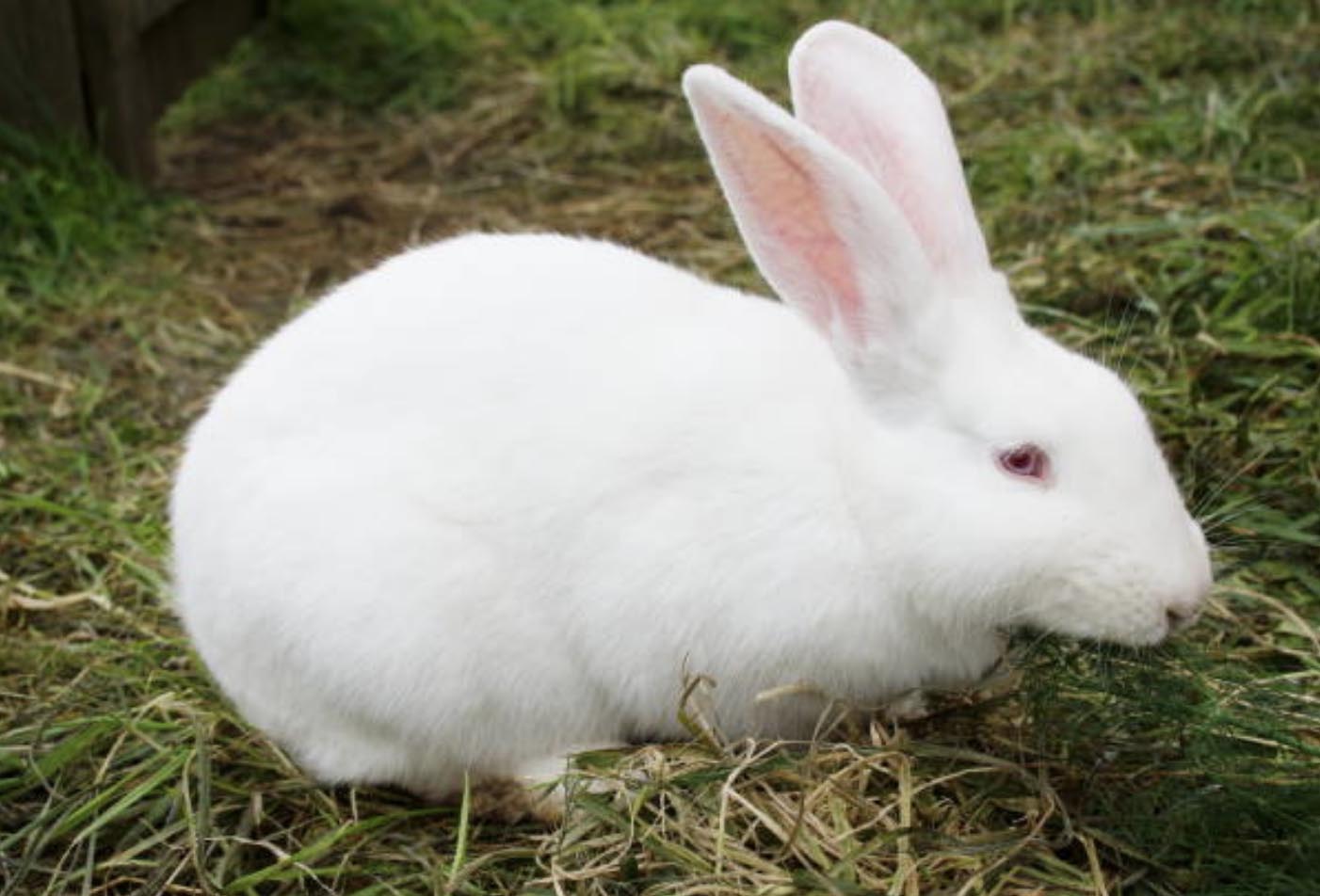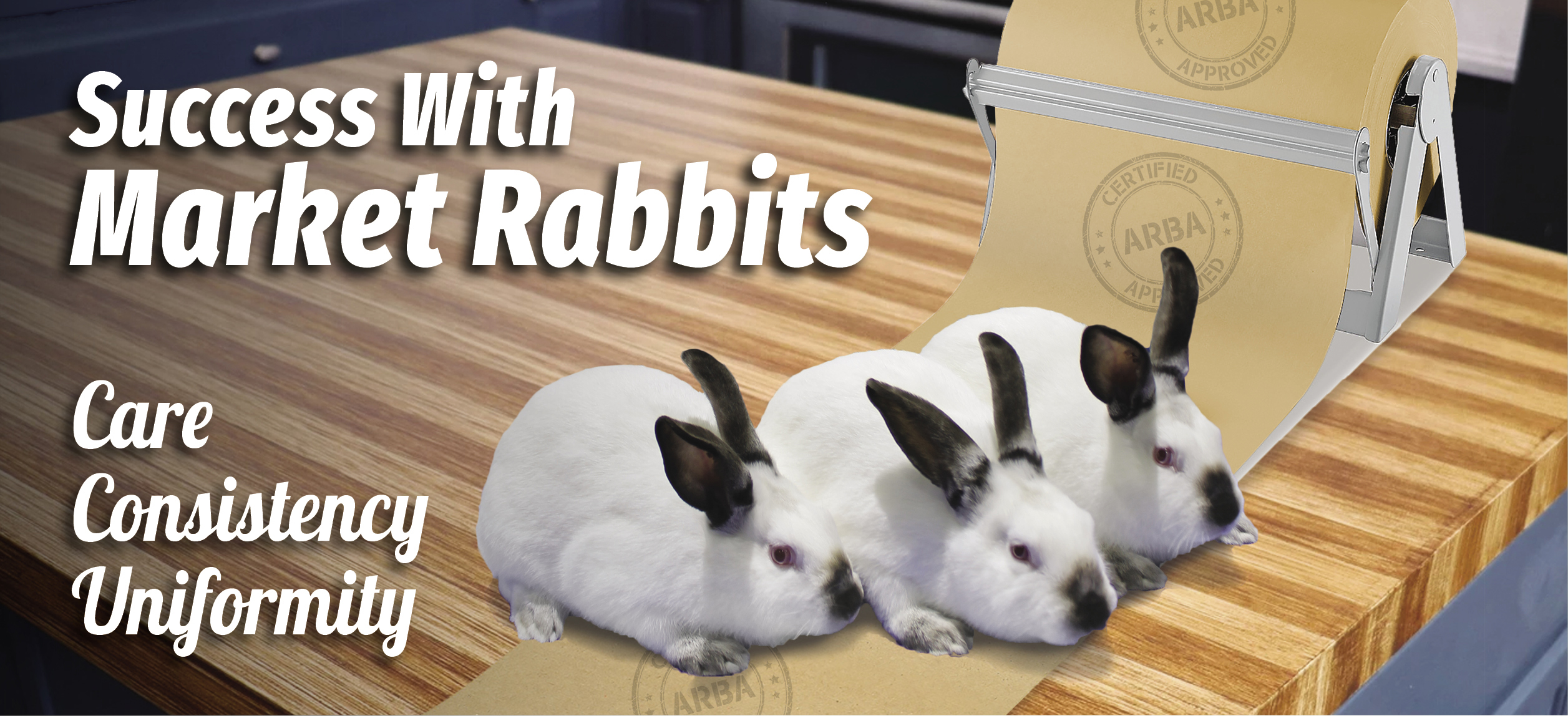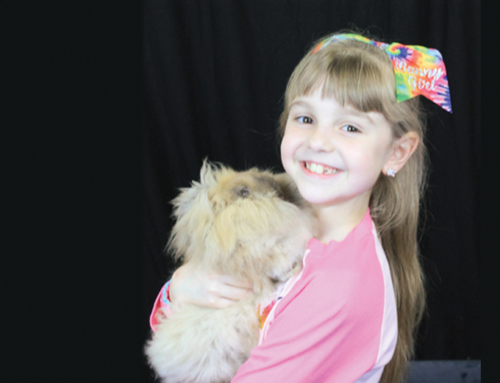
Exhibiting a pen of rabbits for market class competition at the county fair can be a fun, rewarding, educational, and even profitable project with the right care, feeding, and management. Whether this is your first time as a rabbit owner or not, here are some important points to help keep your market fryers on a track to success!
Make a Timeline
Whether you are breeding your own meat pen or buying from a breeder, the first step is to find out where and when you intend to show. Meat pen and single fryer entries must conform to a certain age (under 70 days) and weight (3 lb 8 oz to 5 lb 8 oz). This means it’s important to know the show dates of your intended show (i.g. state, county, local fair…). Carefully review the ownership rules within the fair catalog. Many fairs have a strict ownership rule of 30 days before the rabbits arrive (or in some cases, judging date). Once you know the important dates, you can create a timeline to help you maximize your success while abiding by fair and ARBA rules and standards. If the maximum age for market fryers is 70 days, the combination of gestation and potential ownership days can leave you with a very small and precise window on your timeline.
Deciding on a Breed
Fryers are young market rabbits (under 70 days) which comprise a meat pen or single fryer class. While a single fryer entry is just one rabbit, a meat pen consists of three rabbits of the same breed and variety (not sex). Commercial breeds such as Californians and New Zealands are tried and true choices due to their long history and purpose as fast-growing meat rabbits with excellent meat to bone ratio. However, any breed is allowed to compete in these classes so long as they meet minimum standards in weight, age, and are of the same breed and variety.
Finding Your Market Fryers
Once you have selected a breed, decide whether you want to raise your own market fryers or purchase them from a breeder. As stated earlier, consult your fair’s catalog and rules to see possible restrictions on birth and ownership. While many fairs allow exhibitors to purchase their market fryers, some require the market rabbits to be bred-by and born on the exhibitor’s property. If exhibitors are allowed to purchase from a breeder, check national breed club websites to find breeders near you, wwww.arb.net/affiliated-clubs/
Regardless, a meat pen consists of three rabbits; so, whether you’re purchasing from a breeder or breeding your own, have extra fryers as back-ups should problems arise.
Taking Home Your Market Fryers
If you’re purchasing from a breeder, while adhering to a fair’s ownership rule of 30 days, you are frankly buying baby rabbits who may be freshly weaned from a doe. Your care begins from the very moment you purchase your fryers. Their growth and show potential quickly hinge on your attention to details and their well-being. Maintaining an environment that is as close to what they are accustomed to will decrease stress and put them on a strong path. When you pick up your young fryers from the breeder, come prepared with a transport cage of adequate size and ventilation. Add a handful of timothy hay and offer fresh, cool water too. A cardboard box without bedding, on the contrary, will be a slippery, frightening ride with low airflow. When your fryers make it to your home, they are more likely to drink, eat, and adjust faster if they are not stressed. Fryers that adjust smoothly to their environment will grow the best for you. Remember your timeline. Every day matters, and a day or two without eating due to stress will mean time without growth.
Record Keeping
An accurate record of your fryer’s growth and weight gains must be kept if you wish to succeed with your project. From the moment the fryers are brought home, or weaned, bi-weekly weighing must begin. As the rabbit grows and the competition nears, daily weighing and adjustments are important to note. Keep in mind that they often gain weight at the rate of 1.5-2.0 oz per day during the final weeks! Weigh the fryers around the same time each day, preferably during the estimated time they will be shown. Remember that if they still have food in their gut the weight will reflect that as well.
Temperature
Rabbits are covered in a soft, dense coat of fur that keeps them protected in the wild from the cold and wet. However, if you live in a warm environment, your rabbit is nearly living in a permanent winter coat. Even if you’re chilly on a winter morning, there’s a good chance your rabbit is perfectly comfortable. You can minimize stress by making sure your rabbits never get hotter than 80 degrees. Keep your rabbits out of direct sunlight and offer good airflow.
Rabbits living in a cage means they are sitting above their waste. Airflow minimizes odor and promotes a cooler temperature.
Housing
Fryers do best when given their own cage, own water, and own food. In other words, when the chances to compete with other rabbits is minimized, the accessibility to crucial ingredients increases and so, in turn, does growth. With that said, if you are purchasing a group of young fryers, consider keeping 4 to 6 together for the first few days. When purchasing from a breeder, there’s a good chance your fryers are littermates and accustomed to each other (smell and habits). Being with littermates for the first few days in your new environment will be effective in minimizing their stress levels, while effectively increasing the likelihood of their growth and success.
Wire mesh cages are the best for the rabbits because they allow airflow and ventilation, as well as healthy separation from manure and urine. Solid cages, especially those made of wood, do not promote airflow, can become hot, and harbor bacteria. Metal, on the contrary, can easily be sanitized with bleach; wood cannot. After the first week, separate the rabbits into their own individual cages. An appropriate size cage for each rabbit is 18” x 24” x 14” (L x W x H).
Placement of the cage is also very important. The cage needs to be out of direct sunlight and out of the rain and wind. An ideal location has good airflow, cool temperatures, and quiet surroundings (especially from dogs and loud noises). Placing the cages in the house or garage can promote safety, vigilance and constant temperature, but can increase stress from people and pets (i.g. supposed predators).
Feeding Your Market Fryers
While every breeder has his or her own feeding techniques, tips, and “do’s and do-not’s”, one thing breeders will all agree on is that consistent, quality nutrition will yield in better outcomes compared to rabbits who are fed low quality ingredients on an erratic schedule. Whenever possible, feed the exact feed (brand and blend) that your original breeder fed. If you don’t have access to this feed where you live, ask your breeder for a couple pounds of feed for you to mix with your own feed for the first few days. Just as important as keeping an environment that is similar to where the fryers were raised, so too is offering a familiar feed.
Hay
As you can see, reducing stress is a familiar objective. Stress will prevent your young fryers from normal and essential functions such as drinking, eating, and consequently growth. Stress also has adverse effects on the health of rabbit’s gastrointenstinal tract. Believe it or not, the pH in a rabbit’s gut will change under times of stress. An imbalance of acidity will make an environment more conducive to harmful bacteria. At times of stress, coccidia can overtake the gut and quickly lead to diarrhea, dehydration and death. A buildup within the gut during this time can exponentially increase the ideal environment for this bacteria. Offering a daily, low protein roughage, such as timothy hay, will help to promote movement within the gut, and the removal of the environment which harbors the harmful bacteria. Hay promotes gut movement. Gut movement promotes a healthy, growing rabbit.
Water
Water is critical to the health and growth of all living things. Water must contain three key components: abundant, cool, and clean. Water must always be available. If you offer a water bottle and the rabbits don’t drink from it, you must immediately offer a water dish. At least 32 oz of water should be available to each rabbit at all times. Just like you would not want to drink warm or dirty water, the same is true for your rabbits. If the water is cool and clean, they will drink it. Rabbits that drink are rabbits that will eat.
Handling
Rabbits are most comfortable around other rabbits because rabbits are not predators. At home, while it’s a good idea to feel your rabbits a few times per week to make sure that they do not feel thin, bloated, and that they are growing, it’s best not to over handle them. The more they are scared, the more stressed they become, and consequently the less they will eat and grow correctly. Your rabbits will be happiest and most comfortable without a lot of handling.
While they are cute, it is best to consider them as livestock instead of house pets.
Diarrhea
The fragility of young rabbits is a very real feat to overcome in market rabbit projects. Diarrhea means the ultimate loss of excessive amounts of water. Offering low-protein hay daily (as previously mentioned) will minimize diarrhea. You may also consider sprinkling raw, uncooked, oats on top of the feed to entice eating, add fiber, and minimize diarrhea. Giving an oral probiotic to help replenish the gut with “good bacteria” after the excessive losses from diarrhea will also prove effective.
Conditioning & Grooming
In the weeks leading up to the competition you will want to ensure that your fryers are in prime condition. The flesh must be firm and solid with no flabbiness, looseness of flesh or softness. Be sure the bellies are not potty or distended. The pelt must be tight and the fur must be in prime condition, spotless and display evidence of consistent care.
Nutrition is key at this time. Measure each ration carefully (generally 8 oz/day) and observe that the rabbits are consuming the entire measure. Weigh the animals to ensure that they are developing correctly. If the animal is down a few ounces you’re in a better position to take immediate action to discern the problem and correct it before it becomes serious. Check the following: Is the water clean and plentiful. Has the carefully measured feed been consumed Is there evidence of evidence of diarrhea in the cage or on the rabbit? Is the rabbit’s belly displaying signs of pottiness, or is there a general air of weakness or listlessness in the rabbit? Immediate action can stop a small problem from becoming a bigger one.
Grooming simply consists of dampening one’s hands with water and running it along the body of the rabbit. Water remains the single best ingredient for this job. It will clean the fur without removing the natural oils in the coat. Gently work the fur to remove any dead hair, dust and dander. Grooming also allows one the opportunity to perform a health check – Teeth for alignment, vent for cleanliness, eyes for brightness, belly for firmness, body for smoothness. Remember, stains are harder to get out than to keep out. Cages must be kept sparkling clean at all times. If you do have a stain in the coat remove it asap. The longer it sets the harder it will be. Resist using a product with too many chemicals as it will strip the coat.
Meat Pen Selection
As the competition draws near, you will want to give thought to your selection. Your market meat pen should be as uniform as possible in all aspects: Weight, size, condition, appearance, fur and fleshing. You are looking for three rabbits that are exactly identical. Remember that if even ONE rabbit in your meat pen is over or underweight, the entire entry will be disqualified!
In addition, all rabbits must be free of general disqualifications per the ARBA Standard of Perfection. This means that if one rabbit has bad teeth or a broken toe, the entire entry will be disqualified. Check your entry carefully.
Single Fryer, Roaster, Stewers
When selecting your entry of single fryers, roasters or stewers you are looking for the rabbit that most closely conforms to the required weight of that category. Understanding that meat type is key you will select the rabbit that is full, solidly fleshed and round; an animal that will butcher out with the maximum amount of meat with minimum offal. Well-developed shoulders are indicative of meat carrying properties, as are a wide and deep loin and thick hindquarters. Once you have selected the animals that best meet those requirements, you will then select for firmness of flesh, superiority of condition, and quality of fur. Once you have selected your entry, tattoo them and begin the final weeks of conditioning.
The Final Weeks
While the weeks before the big show can be exciting, resist the urge to over handle your entry. Stress will quickly cause your entry to lose condition. Weigh them and handle them minimally, but watch them carefully to ensure they have everything they need.
Show Day
Stay organized. Have your equipment ready the day prior to leaving. Load your rabbits right before you leave to minimize travel stress. Putting a layer of thick foam padding where the rabbit carrier will sit will act as a cushion to absorb the shock of the road. Each big bump is flesh condition lost. Be sure the air in the vehicle is circulating, and they are adequately cooled and out of direct sunlight during travel. At the show groom/check your rabbits and then put them in an area with the least amount of excitement and traffic possible. If you are required to coop them, then make sure they are as comfortable as possible. Bring your own food and water as some rabbits are finicky about strange tastes and you do not want to do anything to cause them to go off feed. Now is not the time to experiment with a new conditioner, feed or water product.
Groom your entry before you take them before the judge, place them in the coop and then stand back. Market shows are exciting and a wonderful learning opportunity. Pay attention to the judge and what he or she is saying, but save any questions for the conclusion of judging when it is appropriate to talk.
Commercial shows are growing with each passing year. They have become competitive and the premiums can be high. It can be exciting to be awarded the grand champion meat pen, fryer, roaster or stewer. Almost as exciting is the chance to learn tips from top exhibitors, from seasoned judges, and to build a plan of success for the following year. Winning market rabbit projects are never an accident. They are a result of hard work, perseverance, consistency, sacrifice, and meticulous care.
Remember that sometimes you will win and sometimes you will learn. Regardless, of the outcome, you must always remember to have a winning attitude. Good sportsmanship is the mark of a good showman. Shake the hand of the judge, and congratulate the winner. If that person happens to be you, be gracious and humble in your victory.
For a PDF of the Published Article as printed in the November/December 2019 Domestic Rabbits Magazine Click Here





